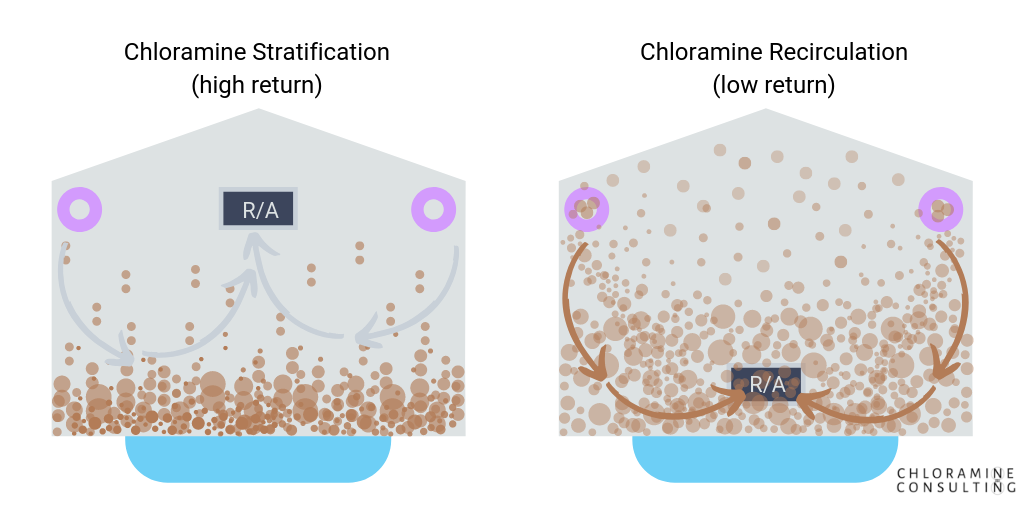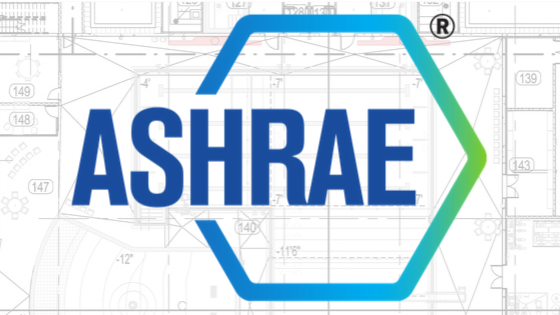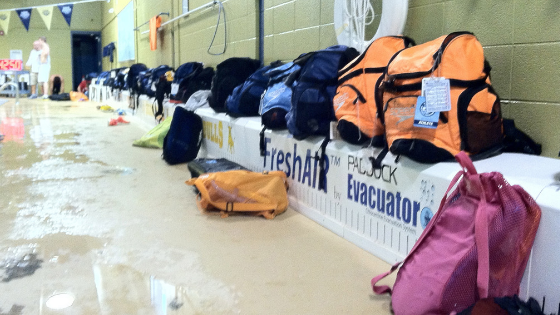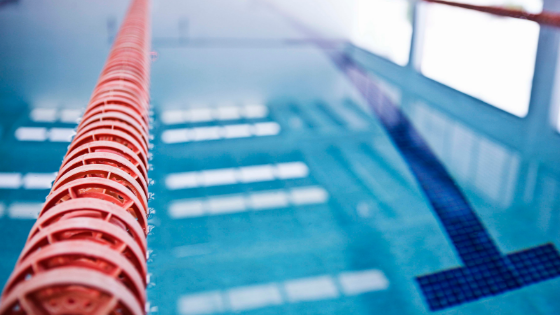Debunking 'Solution by Dilution' for Indoor Swimming Pools
The old, obsolete approach to natatorium air quality sounded like "the solution to pollution is dilution." In other words, introduce excess outdoor air (OA)–and exhaust more air accordingly–to improve indoor air quality. The goal was to dilute the chloramines and other DBPs with fresh outside air.
It would be one thing if dilution actually solved indoor air quality problems. But at best, it only helps with some symptoms. Air dilution does nothing to actually remove chloramine vapor pollution from the space. The 'solution by dilution' method also overlooks the astronomical energy costs of conditioning so much outside air. It also ignores the stress this puts on pool dehumidifiers and other equipment. These are important factors! Controlling energy costs is critical for indoor pools–that is, if they are to be fiscally solvent.
So 'solution by dilution' costs a wad of operating dollars, and does not even solve the real problem. So in our opinion, the strategy is not a solution at all. It's a waste of money.
What does Solution by Dilution Mean?
Dilution applies both to water chemistry and indoor air quality. First, let's touch on water chemistry briefly, and then focus on what this article is really about: indoor air quality.
Swimming Pool Dilution
In water chemistry, certain things stay in water for a long time. The common substances we think of–like salt and calcium carbonate–contribute to Total Dissolved Solids (TDS). Other things stay in the pool long-term as well, like cyanuric acid (CYA) and metals. The swimming pool filtration system cannot remove these things, and they don't go away...so they just accumulate over time. The easiest, most cost-effective and safest way to reduce TDS and CYA is to drain and refill some water. In other words, dilution.
Solution by dilution in water chemistry makes a lot of sense. In water, the "pollution" we are referring to is evenly dispersed throughout the water, which is an important distinction to make when comparing water dilution to air dilution. Diluting pool water by replacing some of the pool with fresh water is a good practice for maintaining balanced water. Just make sure you test the tap water and know what is going into the pool.
Air Dilution
As mentioned in the last paragraph, dilution of water makes sense because the "pollution" of accumulating TDS and CYA is evenly spread throughout the water. Indoor air quality, however, is very different. Airborne chloramines and other DBPs are not evenly spread throughout the natatorium; they are concentrated in the lowest parts of the room. If chloramines were spread evenly around in the air, we would support dilution as a viable answer. But that's not how it is.
So let's talk about what diluting air really means.
Indoor air quality standards are defined by ASHRAE in their design guidelines. Specifically, ASHRAE section 62.1. ASHRAE §62.1 sets the minimum amount of outside air that must be introduced into a conditioned space during occupied hours. For instance, the 2013 ASHRAE standard for a school classroom is 10 CFM per person.1 That's ten cubic feet per minute, per person. So HVAC systems are designed to meet that standard, based on a maximum occupancy allowed in each classroom. That's pretty simple for a mechanical engineer to figure out. It's easy math.
Natatoriums are not so easy.
Don't get us wrong...the standard itself sounds pretty easy. Section 62.1 says you need 0.48 CFM per square foot of wetted surface area. Simply adding 6 feet of splash zone around the area of the swimming pool will give us that number. No problem. The issue is, the standard is just a miniumum amount of outside air required. That number does not take into account where the air pollution is concentrated.
What air is being diluted?
The air being diluted is the air being brought into the return intake, and exhaust fans (if they are separate). If the return intake vent is at ground level, hey, there's probably a good amount of chloramines being diluted out, and that's great. It's a double-edged sword though, as floor returns also cause recirculation problems. Chloramines that do not get exhausted out will recirculate. See the image below, and look at the recirculation diagram on the right.

On the other hand, with high return intake vents, as shown on the left diagram above, the air being diluted is the best air in the room. Yes, it's warmer and more humid, but it has a low percentage of chloramine pollution.
These two examples illustrate why solution by dilution is largely ineffective, and is not much of a solution at all. Diluting the space does not address the source of the problem directly. So what's the ideal method?
Source-Capture Exhaust is better than dilution
Source-capture exhaust still allows for ASHRAE 62.1 to be met, while not needing to exceed it. The exhaust system is patented by Paddock, and it is called the Paddock Evacuator®. It is strategically placed in the room, and the rest of the mechanical system is modified as needed to create an airflow that captures and removes chloramine pollution from the room. This way, excess dilution is unnecessary. The standard outdoor air minimums are brought in by the Pool Dehumidification Unit (PDU), and the Evacuator removes the bad air.
Source-capture replaces exhausts located in return intake ducts, and also ceiling exhausts. On paper, it's a simple replacement, though engineering the system to fit an existing facility can be quite involved. Designing these source-capture systems for new and existing natatorium facilities is what we do. It takes a site visit to gather information about the facility, then we work with a mechanical engineer that the pool owner selects to design a custom source-capture Evacuator system for that facility.
Using the Evacuator exhaust is considerably more cost effective in the long term than solution-by-dilution in energy costs alone. If you have an existing facility with bad air quality, maybe we can help. If you are designing a new facility, it's even easier, because we can help you design this technology into the natatorium before construction even begins.
1 2013 ASHRAE Standard 62.1. Table 6.2.2.1 Minimum Ventilation Rates in Breathing Zone. Page 2.

 By
By



